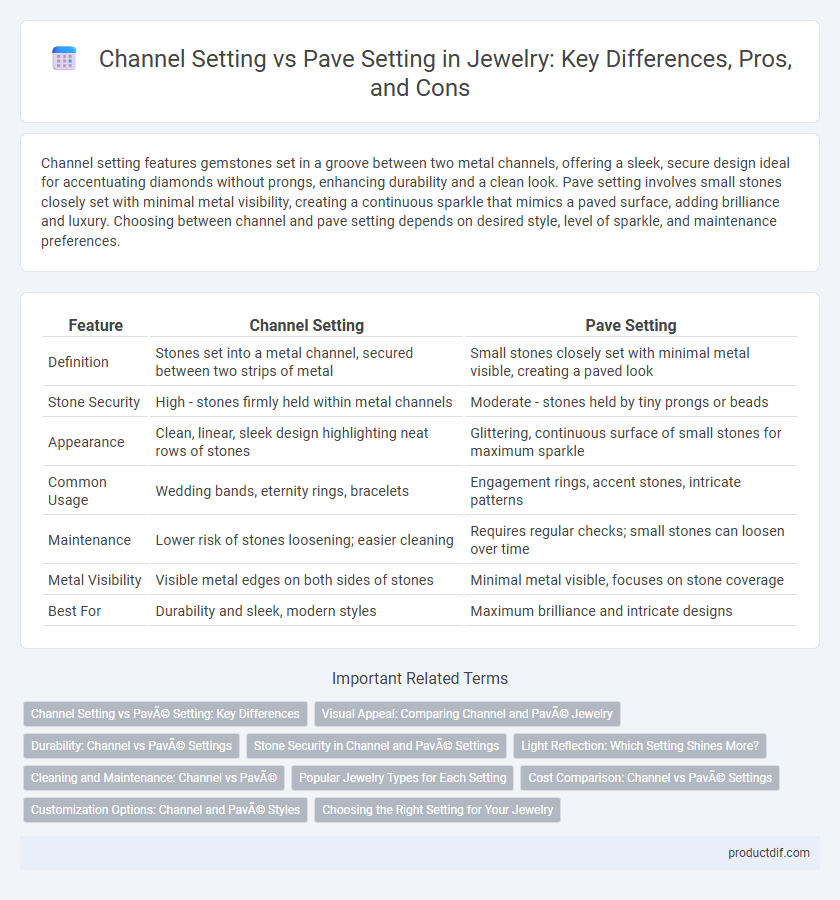Channel setting features gemstones set in a groove between two metal channels, offering a sleek, secure design ideal for accentuating diamonds without prongs, enhancing durability and a clean look. Pave setting involves small stones closely set with minimal metal visibility, creating a continuous sparkle that mimics a paved surface, adding brilliance and luxury. Choosing between channel and pave setting depends on desired style, level of sparkle, and maintenance preferences.
Table of Comparison
| Feature | Channel Setting | Pave Setting |
|---|---|---|
| Definition | Stones set into a metal channel, secured between two strips of metal | Small stones closely set with minimal metal visible, creating a paved look |
| Stone Security | High - stones firmly held within metal channels | Moderate - stones held by tiny prongs or beads |
| Appearance | Clean, linear, sleek design highlighting neat rows of stones | Glittering, continuous surface of small stones for maximum sparkle |
| Common Usage | Wedding bands, eternity rings, bracelets | Engagement rings, accent stones, intricate patterns |
| Maintenance | Lower risk of stones loosening; easier cleaning | Requires regular checks; small stones can loosen over time |
| Metal Visibility | Visible metal edges on both sides of stones | Minimal metal visible, focuses on stone coverage |
| Best For | Durability and sleek, modern styles | Maximum brilliance and intricate designs |
Channel Setting vs Pavé Setting: Key Differences
Channel setting features gemstones securely nestled between two metal strips, creating a smooth, continuous groove that protects the stones and offers a sleek, modern look. Pave setting involves multiple small stones closely set with tiny prongs or beads, maximizing sparkle with minimal metal visibility and a textured surface. The key differences lie in the level of stone protection, visual effect, and the overall design style, where channel setting emphasizes durability and streamlined aesthetics, while pave setting highlights brilliance and intricate detail.
Visual Appeal: Comparing Channel and Pavé Jewelry
Channel setting showcases gemstones aligned in a sleek, continuous row, offering a modern and smooth visual appeal that emphasizes clean lines and symmetry. Pave setting features numerous small stones closely set with minimal metal visibility, creating a glittering surface that maximizes sparkle and brilliance. The visual impact varies with channel setting providing a streamlined elegance, while pave emphasizes intricate shimmer and texture.
Durability: Channel vs Pavé Settings
Channel settings offer superior durability by securely locking gemstones between two metal strips, minimizing exposure to external impacts and reducing the risk of stones loosening. Pave settings feature numerous small stones held by tiny prongs, making them more susceptible to damage and stone loss during rigorous wear. For jewelry intended for everyday use, channel settings provide a more robust and long-lasting option compared to pave settings.
Stone Security in Channel and Pavé Settings
Channel setting offers superior stone security by embedding gemstones within a continuous metal channel, protecting edges from impact and reducing the risk of prong damage or stone loss. Pave setting uses numerous small prongs or beads to hold stones closely together, enhancing brilliance but requiring more frequent inspections to ensure prongs remain intact and secure. Jewelers often recommend channel settings for active wearers seeking durability, while pave settings appeal for their sparkling aesthetics despite slightly less robust stone retention.
Light Reflection: Which Setting Shines More?
Channel setting features gemstones secured between metal strips creating a smooth surface, enhancing light reflection with a continuous sparkle along the band. Pave setting involves multiple small diamonds set closely with minimal visible metal, maximizing light refraction and producing intense brilliance and shimmer. Comparatively, pave setting shines more due to the increased number of exposed diamond facets that catch and reflect light from various angles.
Cleaning and Maintenance: Channel vs Pavé
Channel settings offer easier cleaning and maintenance due to their smooth metal walls that securely hold stones in place, minimizing dirt accumulation. Pave settings require more meticulous cleaning because of multiple small stones set closely with tiny beads, creating crevices that trap dirt and require specialized tools or ultrasonic cleaners. Regular inspection is essential for pave settings to prevent stone loosening, whereas channel settings generally offer more durability with less frequent upkeep.
Popular Jewelry Types for Each Setting
Channel settings are popular in wedding bands and tennis bracelets due to their sleek, secure placement of diamonds within metal grooves, enhancing durability and everyday wear. Pave settings are commonly found in rings, pendants, and earrings where numerous small stones create a continuous, sparkling surface that maximizes light reflection. Both settings offer distinct visual effects, with channel settings providing a modern, streamlined look, while pave settings emphasize intricate detail and brilliance.
Cost Comparison: Channel vs Pavé Settings
Channel settings generally incur higher costs than pave settings due to the precise craftsmanship and metalwork required to create secure grooves for each stone. Pave settings, which involve setting smaller stones closely together with minimal metal showing, tend to be more cost-effective because they use less metal and simpler techniques. Both settings impact the overall price by influencing labor intensity and material usage, with channel settings often reflecting a premium for durability and design complexity.
Customization Options: Channel and Pavé Styles
Channel setting offers sleek customization with continuous grooves that securely hold gemstones in a clean, linear arrangement, ideal for creating elegant bands and bracelets. Pave setting allows for intricate customization by embedding numerous small stones closely together with minimal metal visible, enhancing sparkle and creating a shimmering surface. Both styles provide versatile design options, with channel focusing on structured lines and pave emphasizing densely packed brilliance.
Choosing the Right Setting for Your Jewelry
Channel setting offers a sleek, continuous row of diamonds secured between metal walls, ideal for durability and modern aesthetics. Pave setting features numerous small stones closely set with minimal metal showing, creating a sparkling, intricate surface ideal for delicate designs. Selecting the right setting depends on the wearer's lifestyle and design preference, balancing security and sparkle for optimal jewelry appeal.
Channel setting vs pavé setting Infographic

 productdif.com
productdif.com